人教版高中英语必修一Unit4整体教案.docx
最新人教版高一英语-必修1Unit4说课教案、教学设计
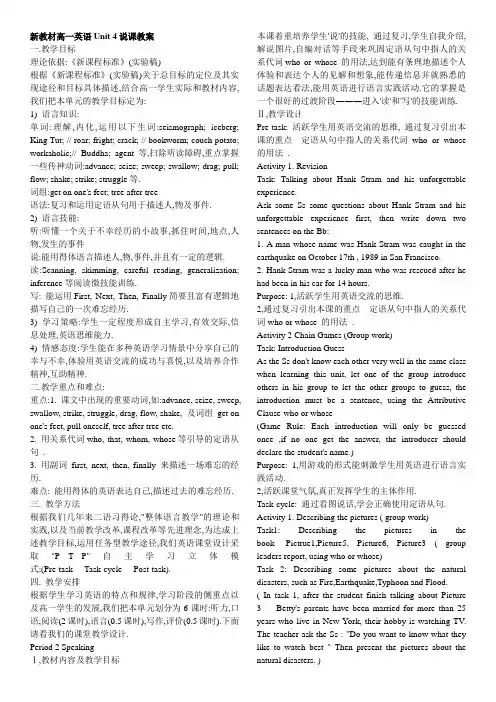
新教材高一英语Unit4说课教案一.教学目标理论依据:《新课程标准》(实验稿)根据《新课程标准》(实验稿)关于总目标的定位及其实现途径和目标具体描述,结合高一学生实际和教材内容,我们把本单元的教学目标定为:1) 语言知识:单词:理解,内化,运用以下生词:seismograph; iceberg; King Tut; // roar; fright; crack; // bookworm; couch potato; workaholic;// Buddha; agent等,扫除听读障碍,重点掌握一些传神动词:advance; seize; sweep; swallow; drag; pull; flow; shake; strike; struggle等.词组:get on one's feet; tree after tree语法:复习和运用定语从句用于描述人,物及事件.2) 语言技能:听:听懂一个关于不幸经历的小故事,抓住时间,地点,人物,发生的事件说:能用得体语言描述人,物,事件,并且有一定的逻辑. 读:Scanning, skimming, careful reading, generalization; inference等阅读微技能训练.写: 能运用First, Next, Then, Finally简要且富有逻辑地描写自己的一次难忘经历.3) 学习策略:学生一定程度形成自主学习,有效交际,信息处理,英语思维能力.4) 情感态度:学生能在多种英语学习情景中分享自己的幸与不幸,体验用英语交流的成功与喜悦,以及培养合作精神,互助精神.二.教学重点和难点:重点:1. 课文中出现的重要动词,如:advance, seize, sweep, swallow, strike, struggle, drag, flow, shake, 及词组get on one's feet, pull oneself, tree after tree etc.2. 用关系代词who, that, whom, whose等引导的定语从句.3. 用副词first, next, then, finally 来描述一场难忘的经历.难点: 能用得体的英语表达自己,描述过去的难忘经历.三. 教学方法根据我们几年来二语习得论,"整体语言教学"的理论和实践,以及当前教学改革,课程改革等先进理念,为达成上述教学目标,运用任务型教学途径,我们英语课堂设计采取"P---T---P"自主学习立体模式:(Pre-task----Task-cycle----Post-task).四. 教学安排根据学生学习英语的特点和规律,学习阶段的侧重点以及高一学生的发展,我们把本单元划分为6课时:听力,口语,阅读(2课时),语言(0.5课时),写作,评价(0.5课时).下面请看我们的课堂教学设计.Period 2 SpeakingⅠ,教材内容及教学目标本课着重培养学生'说'的技能, 通过复习,学生自我介绍,解说图片,自编对话等手段来巩固定语从句中指人的关系代词who or whose 的用法,达到能有条理地描述个人体验和表达个人的见解和想象,能传递信息并就熟悉的话题表达看法,能用英语进行语言实践活动.它的掌握是一个很好的过渡阶段―――进入'读'和'写'的技能训练. Ⅱ,教学设计Pre-task: 活跃学生用英语交流的思维, 通过复习引出本课的重点---定语从句中指人的关系代词who or whose 的用法.Activity 1. RevisionTask: Talking about Hank Stram and his unforgettable experience.Ask some Ss some questions about Hank Stram and his unforgettable experience first, then write down two sentences on the Bb:1. A man whose name was Hank Stram was caught in the earthquake on October 17th , 1989 in San Francisco.2. Hank Stram was a lucky man who was rescued after he had been in his car for 14 hours.Purpose: 1,活跃学生用英语交流的思维.2,通过复习引出本课的重点---定语从句中指人的关系代词who or whose 的用法.Activity 2 Chain Games (Group work)Task: Introduction GuessAs the Ss don't know each other very well in the same class when learning this unit, let one of the group introduce others in his group to let the other groups to guess, the introduction must be a sentence, using the Attributive Clause-who or whose(Game Rule: Each introduction will only be guessed once ,if no one get the answer, the introducer should declare the student's name.)Purpose: 1,用游戏的形式能刺激学生用英语进行语言实践活动.2,活跃课堂气氛,真正发挥学生的主体作用.Task-cycle: 通过看图说话,学会正确使用定语从句. Activity 1. Describing the pictures ( group work)Task1: Describing the pictures in the book----Pictrue1,Picture5, Picture6, Picture3 ( group leaders report, using who or whose)Task 2: Describing some pictures about the natural disasters, such as Fire,Earthquake,Typhoon and Flood. ( In task 1, after the student finish talking about Picture 3---- Betty's parents have been married for more than 25 years who live in New York, their hobby is watching TV. The teacher ask the Ss : "Do you want to know what they like to watch best " Then present the pictures about the natural disasters. )Purpose: 1,培养学生积极用英语进行交流和沟通,发挥合作精神.2,培养学生看图说话的能力,从而提高'说'的技能. Activity 2. Creating dialogues (pair work)Task: Each pair choose two of the pictures and create their own dialogues.(using at least one Attributive Clause)Purpose: 1,培养学生善于利用各种机会用英语进行真实交际.2,增强学生的自信心,丰富想象力和独到的见解.3,了解英语国家与中国的生活方式的不同.Activity 3. Enjoying the videoThis video is about the most terrible disaster this year----SARS, some doctors are treating patients, struggling against SARS)Task 1: To enjoy the video, finding out something that moved you deeply.Purpose: 1,能传递信息并就熟悉的话题表达看法2,能有条理地表达个人的见解和想象, 从而提高'说'的技能.Task 2: Interviewing--- group work( suppose one is the doctor, the others are going to interview him)Purpose: 1,能用英语进行语言实践活动.2,能用恰当的方式在特定场合中表达观点,从而使'说'的技能的训练进一步提升.Post-task: 评价学生课堂表现,学生表演对话Activity : Act out dialoguesPeriod I warming up and listeningⅠ,教材内容及教学目标本课处于本单元的第一课时,主要训练和提高学生'听'的技能,它的掌握有利于以下几课的'说','读'和'写'的技能训练,并作了一个很好的铺垫.本课的听力材料由两部分组成,主要讲述Hank Stram在地震前所做,地震中所见,所闻和所感的令人难忘的经历.通过完成练习,学生能抓住所听语段中的关键词,理解话语之间的逻辑关系,听懂故事,理解其中主要人物和事件以及他们之间的关系等.而且学生能掌握较好的听力方法,如积极预测,注意抓关键词,善于跳跃难点,学会做笔记等等.通过本课学习学生能复习定语从句以及学会正确使用指人或物的关系代词. Ⅱ,教学设计A. Warming up :Task 1 Matching competition (group work)Column A Column B1, Fu Jian Province a,a cartoon maker2, San Francisco b,the electric lamp3, Alexander Bell c,the first telephone4, Thomas Edison d,earthquake5, Albert Einstein e,typhoon6, Walt Disney f,the Theory of Relativity Question: Why do you think soTask2: Looking at the following pictures, find out the answers to the questions:1) Do you know who or what they are2) What made them unforgettable3) Can you describe each picture using one sentence( with the help of the words under the picture)Task 3: Let the students describe each picture with Attributive Clause.eg: Zhang Heng is the man who made the earliest seismograph in 132.B. Pre-listeningTask1: Before listening , let the Ss guess the possible answers to the following questions according to the situation: (group work)1) When did the earthquake happen2) Where was the man driving when it happen3) What was he going to doListening(Part 1):Task 2: Listening to the tape to get the correct answers to the above questions.(for the first time)Task 3: Listening to the tape to put the following into the right order.( ) 1. I stopped the car and at the same time the road fell onto the cars in front of me.( ) 2. I was hungry so I started to eat one.( ) 3. I saw the cars in front of me start to move from side to side.( ) 4. I had finished work and then gone to the Post Office. ( ) 5. I slowed down ,then my car started to shake.( ) 6. I stopped off at a shop in order to get some fresh fruit. ( ) 7. I drove even slower, then the road above started to fall down.Task 4: Letting the Ss listen to the tape again, then try to retell the story simply, using their own words.Task 5 : Discussion (Group work)What would happen to Hank Stram finallyListening (Part 2)Task1: Listening to the second part to choose the best choices(for the first time)1. Which part of his body hurt badly ( C )A. The bottom parts of his legsB. The bottom parts of his hands.C. The bottom parts of his legs and feet.2. What could he hear below him ( B )A. NothingB. Shouts and noiseC. The noise of cars3. How long had he been in the car ( A)A.14 hoursB. 40 hoursC.4 hoursTask 2: Listening to the tape again to write the words in thespaces.1. I ________ myself in the dark.2. Then I remembered what______.3. It was clear to me now that I ______ in an earthquake.4. Then I ________ people________ towards me.5. A team of people______ to see if anyone _____ under the broken road.C. Post-listening:Task 3: DiscussionWhat made him survive in such a terrible accidentPeriod 5 Language study & Grammar(half period)I,教学设计Task 1. Word puzzleI. Find out ten words that describe the flood and fighting against the flood in the puzzle. One of them has been found out.Task 2. Words in different situationsWord study about "advance" and "strike" (individual work) Judge the different meanings of "advance" or "strike" in the following sentences:1.The hunter advanced toward the bear carefully.2.A month has passed but the project has not advanced.3.He worked so well that his boss advanced him to a higher position.4.The date of the meeting was advanced from June 10 to June 3.5.The boy struck the pig with a stick.6.The workers were striking for higher pay.7.Typhoon Swan struck Hainan, killing 20 people.8.On New Year's Eve, we waited for the clock to strike. Task 3. Finish the exercises in the text.Task 4. Talking about people and things, using Attributive ClauseFirst, let students find out some words about things quickly like clock, homework, coat, chocolate, bag, flood, fire, etc from the exercise of word study and describe them as the following example: (pair work)A clock is a machine that/which tells time.Second, let students find out some words about persons quickly such as teacher,parents, doctor, mother, child, soldier and thief and describe them like this: (pair work)A teacher is a person who/that teaches you how to learn. Third, finish Exercise 2 of Grammar orally. (individual work)Task 5 . Expanded reading1.Read the following passage about fire and find out the Attributive Clauses in it and try to understand the use of the relative pronouns. (individual work)2. Reading comprehensionTask 6. Finish Exercise 1 of Grammar. (individual work) HomeworkPreview the next reading material and find out the Attributive Clauses with who, whom, that, which, whose, where and the linking words and and but.Period 3 &4 ReadingⅠ,教材内容这是新教材高一上第4单元的阅读课型.本课围绕难忘的经历这一主题,描写洪水来临时的凶猛及Jeff与Flora 在这次经历中的体验.本课词汇量大,尤其在描写发洪水时,文章运用大量的动词及一些原汁原味的表达.另外文章中还出现许多定语从句,定语从句是本单元的语法重点.根据新课程标准及高一学生的知识,语言能力水平,我们制定以下教学目标:Ⅱ,教学目标:1,理解和掌握一些新词汇如:roar,mass,fright,rack,boom,advance,seize,destroy,sweep ,swallow,drag,struggle,flow,strike,etc.2, 理解定语从句,如:1) Before she could move, she heard a great noise, which grew to a terrible roar.2) She looked at Jeff who waved his arms.3) There she saw big mass of water that was quickly advancing towards her.4) Flora, whose beautiful hair and dress were all cold and wet, started crying.尤其是whose引导的定语从句及间隔性定语从句.3,学生在一定程度上提高阅读微技能和用英语思维,推理,判断的能力.4,能用First,Next,Then,Finally来口头陈述事件.Ⅲ, 教学设计A. Warming up:Task 1:Talking about natural disasters1. What natural disasters did you talk about yesterday Do you know some others2. Have you ever experienced one of these disasters Can you describe what it was like and how you feltB. Pre-readingTask 2: Looking and guessing:1. What can you see in the picture2. What happened to them finally3. What words will you use to describe this disasterC. Fast readingQuestions:1.What natural disaster did Flora and Jeff suffered (Flood)2. What rescued them (Chimney)D. Careful readingTask 3: Dividing the whole passage according to thechange of the places.Para 1:In the gardenPara2:On the way to the housePara3:Inside the houseTask 4: ImaginationQuestion 1:What was the house like ( B )A,a flat B,a house with two floorsQuestion 2:What words support your ideaTask 5 :Reading for the second time and finish the following diagramplacesfloodreactionfeelingsTask 6 Imaging the end of the storyE. Practice for understanding and word studyF. ConsolidationTask 7,Retelling the story according to the diagram:Post readingTask : Discussion.1, Will the disaster change Flora and Jeff's life How Expanded reading: The Day That Changed My Generation Read the material and do some exercises.Homework:写阅读笔记阅读格式卡Date:Unit ( )Lesson( )General idea:Contents:Comment:板书设计Unit 4 Unforgettable experiencesplacesfloodreactionfeelingfirstin the gardenroar, advancewave, shout runsurprisedpuzzlednexton the way to the housesweep, swallow, flowseize, drag ,go down, open, pull ,look into, hold, strugglefrightenedtheninside the housestrikemove updestroyclimb, cryhopefulFinally:F V I F S E I Z E MOFYKHNGYOJHIDRAGDPTXYFENKICUBSTSSIEBFLOWASTRUGGLEAKERRABNVQLJZOFIHYNPLBXYZOKCGTOADV ANCEFIWF V I F S E I Z E MOFYKHNGYOJHIDRAGDPTXYFENKICUBSTSSIEBFLOWASTRUGGLEAKERRABNVQLJZOFIHYNPLBXYZOKCGTOADV ANCEFIWF V I F S E I Z E MOFYKHNGYOJHIDRAGDPTXYFENKICUBSTSSIEBFLOWASTRUGGLEAKERRABNVQLJZOFIHYNPLBXYZOKCGTOADV ANCEFIWPeriod 6 Writing & assessment(1.5 periods)Ⅰ,教学内容与教学目标学生通过学习一篇四川之行的游记范文,能根据写作步骤提示,用First, Next, Then, Finally组织材料写一篇自己亲身游记(unforgettable trip),并能写出一两个含定语从句的句子.根据克拉申(krashen)的输入假说:"写是输出的过程,是在前面多方式,多渠道的足够可理解输入的情况下,而达到的自然输出.根据我们前面提出的P----T----P自主学习立体模式,我作如下设计.Ⅱ,教学设计Pre-task:激发背景知识,明确写作要求,主题目的,写作步骤Activity 1. remind of the unforgettable experiencesIn our daily, many things are unforgettable. They are worth writing down. For example, (显示画面)a disaster; a war; a match; a speech; a film; a famous person; a talk with somebody; a trip; etc.(目的:承上启下,激发写作情境)Activity 2. travel around our country.For me, going on a trip is really unforgettable because it is exciting and there are a lot to see in our motherland. Look at the pictures and guess where it is.Beijing; *The Great Wall; *Mount Huangshan *Mountain Emei; *Hainang Seaside; etc. (Or local places of interests.) (目的:为阅读做准备;欣赏美丽河山,激发写作欲望;) Activity 3. A trip to SichuanDuring the first week of May, the three boys went on a holiday to Sichuan. Read and find what made the writer unforgettable. (Buddha in Leshan; Monkeys on Mount Emei.)Read again and answer the following questions:1. Why did they choose to go to Leshan and Emei2. How did they get to the top of the mountains3. What did they do before the trip (First, Next )4. What did they see and do on Leshan5. What did they see and do on Mount EmeiPair work: Retell the trip to Sichuan, with the help of the following:During the first week of May I went on a holiday to Sichuan. First.Next.The next dayLeshanThe next morning EmeiFinally…(目的:可理解的输入为写作做语言上的准备)Task-cycle: M-M-C practice ①mechanical practice(学生活动:朗读;找词;找句型)Find the sentence with the following meaning:1) 我找出一些成都附近名胜的照片.2) 我接着打电话给一旅行社,我在报纸上发现它的号码.3) 我们带了几瓶水,一些苹果和橘子,装入我的包里.4) 我们先去乐山,在那里我们一直爬到山顶看佛像.②meaningful practice(学生活动:模仿性造句;仿写作文)围绕Unforgettable trip主题用which; whose; where等造句.③communicative practice(学生活动:回答问题;连句成文;润色) 1. First, students quickly write down 20 short sentences about their trip, with the help of questions in the text.2. Next, students try to put the sentences in order, using "First, Next, Then, Finally"3. Then, students write the story, using linking words and relative pronouns.Post-task:作文展示,交流评价(同伴评价,课堂集体评价,教师评价)同伴评价实际上是合作形学习的一种形式,其重要理论基础就是考卡夫(Kafka, K)最早提出的"群体动力理论"(group dynamics).四, 教学评价通过评价,使学生在英语课程的学习过程中不断体验进步与成功,认识自我,建立自信,调整学习策略,促进学生综合语言支用能力的发展.评价也能使教师获得英语教学的反馈信息,对自己的教学行为进行反思和适当调整.为此,本单元的评价包括以下几项:1, 把阅读格式卡存入学生学习档案夹:阅读格式卡Date:Unit ( )Lesson( )General idea:Contents:Comment:2, 形成性评价3, 单元终结性评价Ⅰ. Multiple choice1. - A ship makes me unforgettable after I saw a famous movie.- Do you mean the ship, Titanic, ______ sank after hitting an icebergA. whoB. whichC. whoseD. where2. - Do you know Zhang Heng- Is he the man _______ made the earliest seismograph in 132A. whoB. heC. whoseD. which3. Flora, _______ garden was swallowed by the flood, was crying.A. whoB. thatC. whoseD. where4. On the top of Leshan, there is a really big Buddha, in front ________ Wei Bin took photos of us.A. itsB. on whichC. from whichD. of which5. - Three young school boys were ______ by the water when swimming on a hot afternoon!- What a bad accident!A. swallowedB. sweptC. gotD. caught6. The lamplight ______ out through the heavy fog, which gave travelers a light of hope.A. struggledB. draggedC. turnedD. found7. On October 17th, 1989 a strong earthquake _____ San Francisco and killed over 100 people.A. advancedB. took placeC. struckD. seized8. Look, the baby lion, which was just born two days ago, is trying to ______ its feet.A. get onB. get ontoC. get upD. get in9. Trees ______ badly during the terrible storm.A. pulledB. shookC. destroyedD. flowed10. Tree after tree was ______ by the water, which must have been three metres.A. cut upB. cut downC. cut offD. cut inⅡ. Cloze testWhat an unforgettable day! At the moment Flora was so surprised at the big _11_ of water which was advancing quickly towards her in her garden that she couldn't move. Jeff rushed to seize her arm and they ran together to the house. _12 they got to the house, the waves _13_ them down twice. Jeff pulled Flora up with a lot of difficulty, _14_ onto a tree that grew against the wall. The water, _15_ was cold as ice and flowed faster than a river, was above her knees. They looked into each other's faces, _16_. The chance of being rescued was slim. They opened the door to the hall and got the chance to climb _17_ to the second floor. The water moved up like a sea. Flora started crying. The house would fall down!They had to find the 18_ because it would stand. Jeff looked out of the window. Tree after tree _19_. The garden was completely destroyed, swept away by the wild water. A terrible noise went through the house. Before the whole house went down in the _20_, they saw the chimney.11. A. group B. collection C. mass D. crowd12. A. Before B. After C. Until D. Once13. A. cut B. swept C. pulled D. went14. A. cracking B. flowing C. holding D. catching15. A. which B. it C. that D. where16. A. frightened B. surprised C. relieved(松口气) D. excited17. A. downstairs B. upstairs C. above D. under18. A. tree B. hall C. tower D. chimney19. A. swept away B. swallowed C. went down D. pulled down20. A. storm B. flood C. earthquake D. fireⅢ. Translation. Put the Chinese into English to complete the following sentences.21. The climate ___________________________(全球的科学家们在担心的) is becoming warmer and warmer. 22. We feel as if the earth were in the greenhouse ______________________(由玻璃做成的).23. The scientist ___________________________(他的研究是关于温室气体的) is doing an experiment.24. We find it hard to find an interesting place__________________________(那里天气不会太热的) in Africa.25. People ______________________(生活在沙漠地区的)lead a hard life.26. Pollution, _______________________(给人类带来重大灾难的), is said to be one of the main causes of global warming.Key:21. (that/which) scientists all over the world are worrying about22. that/which is made of glass23. whose research is about greenhouse gases24. where it is not too hot25. who live in the desert26. which brings man terrible disasters4, 单元测试学生自我评定表单元名称Unit _______失分错解题号错解原因仍存疑点对策5, 任务型活动:配图说明.找出记一次外出游玩的系列照片,制成小册,配以英语说明,然后全班展示.。
高中英语人教版必修1Unit4单元教案全面版
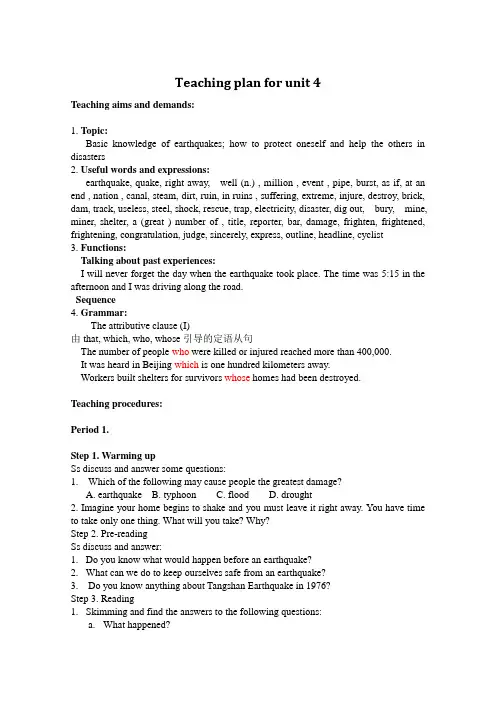
Teaching plan for unit 4Teaching aims and demands:1. Topic:Basic knowledge of earthquakes; how to protect oneself and help the others in disasters2. Useful words and expressions:earthquake, quake, right away, well (n.) , million , event , pipe, burst, as if, at an end , nation , canal, steam, dirt, ruin, in ruins , suffering, extreme, injure, destroy, brick, dam, track, useless, steel, shock, rescue, trap, electricity, disaster, dig out, bury, mine, miner, shelter, a (great ) number of , title, reporter, bar, damage, frighten, frightened, frightening, congratulation, judge, sincerely, express, outline, headline, cyclist3. Functions:Talking about past experiences:I will never forget the day when the earthquake took place. The time was 5:15 in the afternoon and I was driving along the road.Sequence4. Grammar:The attributive clause (I)由that, which, who, whose引导的定语从句The number of people who were killed or injured reached more than 400,000.It was heard in Beijing which is one hundred kilometers away.Workers built shelters for survivors whose homes had been destroyed.Teaching procedures:Period 1.Step 1. Warming upSs discuss and answer some questions:1. Which of the following may cause people the greatest damage?A. earthquakeB. typhoonC. floodD. drought2. Imagine your home begins to shake and you must leave it right away. You have time to take only one thing. What will you take? Why?Step 2. Pre-readingSs discuss and answer:1.Do you know what would happen before an earthquake?2.What can we do to keep ourselves safe from an earthquake?3. Do you know anything about Tangshan Earthquake in 1976?Step 3. Reading1.Skimming and find the answers to the following questions:a.What happened?b.When and where did it happen?3.Ss read the whole passage again and get the main ideas of each part:Part 1. The natural signs of a coming earthquakePart 2-3. The damage of the city after the earthquakePart 4. The help to the survivorsStep 4. ComprehendingSs finish Ex 1 and 2 on page 27.Step 5. Assignment1.Surf the internet and get more information about the earthquake.2.Retell the text.Period 2.Step 1. Warming up1.Ss share more information about the earthquake.2.Ask some Ss to retell the text by using their own words.Step 2. Language points1.lie –lay-lain (v.) : to be, remain or be kept in a certain state 处于某种状态The village lay in ruins after the war.These machines have lain idle since the factory closed.2.in ruins: severely damaged or destroyed 毁坏an earthquake left the whole town in ruins.His career is in ruins.3.number (n.): a quantity of people or things 数目;数量The number of people applying has increased this year.We were fifteen in number.a number of: a lot ofI have a number of letters to write.A large number of people have applied.4. injure (v.): to hurt oneself/sb./ sth. physically 受伤He fell off the bicycle and injured his arm.5. reach (v.): to achieve or obtain sth. 达成;达到;获得Y ou’ll understand it when you reach my age.At last we reached a decision.6. rescue (n.): an act of rescuing or being rescued 搭救;解救A rescue team is trying to reach the trapped mines.Rescue (v.): to save or set free from harm, in danger, or loss 解救;救出The rescued the man from drowning.7. trap(v.): in a place from which one wants to escape but cannot 困住;陷于绝境They were trapped in the burning hotel.8. all …not… = not all…: some but not all 一些;但不是全部Not all the girls left.=Only some of them left early.Not all the children are noisy.=Some of the children are not noisy.全部否定应用: none of…None of us were allowed to go there.None of these reports is very helpful.Step 3. learning about language1. Ss finish Ex 1,2 and 3 on page 27 and 28.2. Teacher checks the answer and give the Ss some help if they have some difficulty. Step 4. assignment1.Finish Wb.Ex.1 on page 63.2.Ss try to remember the useful words and expressions by hearts.Period 3Step 1. Warming upSs read the passage again and try to find the sentences with attributive clauses.e.g. Workers built shelters for survivors whose homes had been destroyed.Step 2. Attributive clause1.Give Ss more sentences and let the Ss to find the structures of the attributive clause.2.Ss do some exercises about how to use that, which, who or whose.3.Ss finish Ex 2 on page 28.Some materials about attributive clause:关系代词引导的定语从句关系代词所代替的先行词是人或物的名词或代词,并在句中充当主语、宾语、定语等成分。
人教版高中英语必修一Unit4整体教案
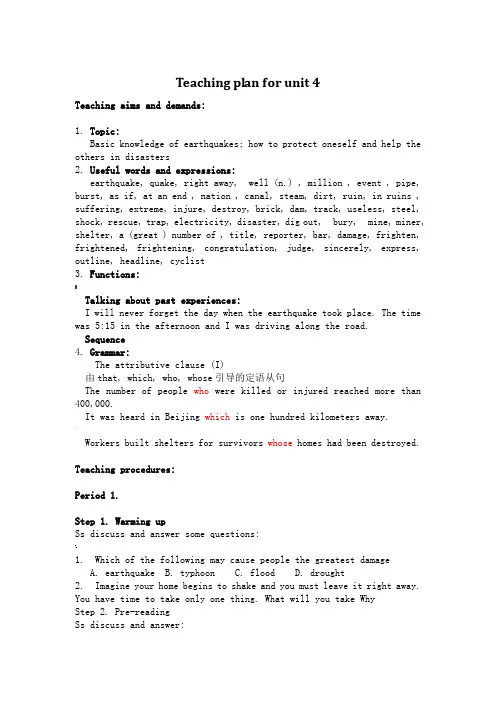
Teaching plan for unit 4Teaching aims and demands:1. Topic:Basic knowledge of earthquakes; how to protect oneself and help the others in disasters2. Useful words and expressions:earthquake, quake, right away, well (n.) , million , event , pipe, burst, as if, at an end , nation , canal, steam, dirt, ruin, in ruins , suffering, extreme, injure, destroy, brick, dam, track, useless, steel, shock, rescue, trap, electricity, disaster, dig out, bury, mine, miner, shelter, a (great ) number of , title, reporter, bar, damage, frighten, frightened, frightening, congratulation, judge, sincerely, express, outline, headline, cyclist3. Functions:]Talking about past experiences:I will never forget the day when the earthquake took place. The time was 5:15 in the afternoon and I was driving along the road.Sequence4. Grammar:The attributive clause (I)由that, which, who, whose引导的定语从句The number of people who were killed or injured reached more than 400,000.It was heard in Beijing which is one hundred kilometers away.`Workers built shelters for survivors whose homes had been destroyed. Teaching procedures:Period 1.Step 1. Warming upSs discuss and answer some questions:%1. Which of the following may cause people the greatest damageA. earthquakeB. typhoonC. floodD. drought2. Imagine your home begins to shake and you must leave it right away. You have time to take only one thing. What will you take WhyStep 2. Pre-readingSs discuss and answer:1.Do you know what would happen before an earthquake2.What can we do to keep ourselves safe from an earthquake3. Do you know anything about Tangshan Earthquake in 1976"Step 3. Reading1.Skimming and find the answers to the following questions:a.What happenedb.When and where did it happen|3.Ss read the whole passage again and get the main ideas of each part: Part 1. The natural signs of a coming earthquakePart 2-3. The damage of the city after the earthquakePart 4. The help to the survivorsStep 4. ComprehendingSs finish Ex 1 and 2 on page 27.Step 5. Assignment1.【2.Surf the internet and get more information about the earthquake.3.Retell the text.Period 2.Step 1. Warming up1.Ss share more information about the earthquake.2.Ask some Ss to retell the text by using their own words.;Step 2. Language points1.lie –lay-lain (v.) : to be, remain or be kept in a certain state 处于某种状态The village lay in ruins after the war.These machines have lain idle since the factory closed.2.in ruins: severely damaged or destroyed 毁坏an earthquake left the whole town in ruins.His career is in ruins.3.number (n.): a quantity of people or things 数目;数量(The number of people applying has increased this year.We were fifteen in number.a number of: a lot ofI have a number of letters to write.A large number of people have applied.4. injure (v.): to hurt oneself/sb./ sth. physically 受伤He fell off the bicycle and injured his arm.5. reach (v.): to achieve or obtain sth. 达成;达到;获得!You’ll unders tand it when you reach my age.At last we reached a decision.6. rescue (n.): an act of rescuing or being rescued 搭救;解救A rescue team is trying to reach the trapped mines.Rescue (v.): to save or set free from harm, in danger, or loss 解救;救出The rescued the man from drowning.7. trap(v.): in a place from which one wants to escape but cannot 困住;陷于绝境They were trapped in the burning hotel.(8. all …not… = not all…: some but not all 一些;但不是全部Not all the girls left.=Only some of them left early.Not all the children are noisy.=Some of the children are not noisy.全部否定应用: none of…None of us were allowed to go there.None of these reports is very helpful.、Step 3. learning about language1. Ss finish Ex 1,2 and 3 on page 27 and 28.2. Teacher checks the answer and give the Ss some help if they have somedifficulty.Step 4. assignment1.Finish on page 63.2.Ss try to remember the useful words and expressions by hearts.Period 3(Step 1. Warming upSs read the passage again and try to find the sentences with attributive clauses.. Workers built shelters for survivors whose homes had been destroyed. Step 2. Attributive clause1.Give Ss more sentences and let the Ss to find the structures of theattributive clause.2.Ss do some exercises about how to use that, which, who or whose.3.Ss finish Ex 2 on page 28.`Some materials about attributive clause:关系代词引导的定语从句关系代词所代替的先行词是人或物的名词或代词,并在句中充当主语、宾语、定语等成分。
Unit4 教学设计 高中英语人教版必修第一册
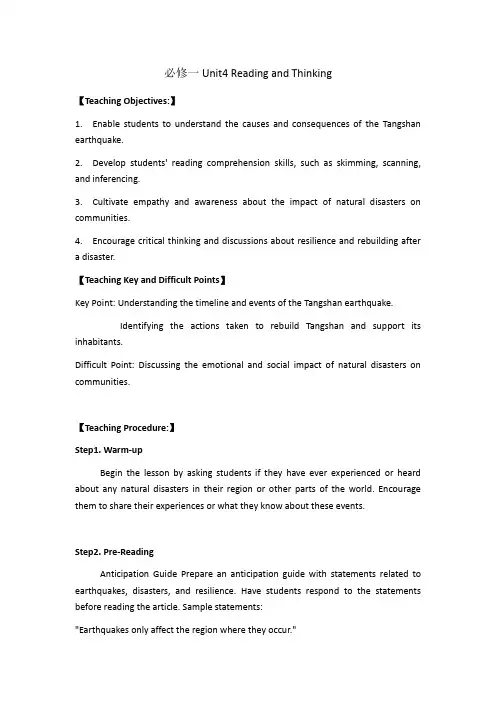
必修一Unit4 Reading and Thinking【Teaching Objectives:】1.Enable students to understand the causes and consequences of the Tangshan earthquake.2.Develop students' reading comprehension skills, such as skimming, scanning, and inferencing.3.Cultivate empathy and awareness about the impact of natural disasters on communities.4.Encourage critical thinking and discussions about resilience and rebuilding aftera disaster.【Teaching Key and Difficult Points】Key Point: Understanding the timeline and events of the Tangshan earthquake.Identifying the actions taken to rebuild Tangshan and support its inhabitants.Difficult Point: Discussing the emotional and social impact of natural disasters on communities.【Teaching Procedure:】Step1. Warm-upBegin the lesson by asking students if they have ever experienced or heard about any natural disasters in their region or other parts of the world. Encourage them to share their experiences or what they know about these events.Step2. Pre-ReadingAnticipation Guide Prepare an anticipation guide with statements related to earthquakes, disasters, and resilience. Have students respond to the statements before reading the article. Sample statements:"Earthquakes only affect the region where they occur.""Rebuilding after a disaster is an impossible task.""People's unity is essential in overcoming a disaster."After the article is read, revisit the statements to discuss whether their opinions have changed.Step3. While-ReadingActivity 1: Visualizing the SceneDisplay a picture of the Tangshan earthquake aftermath, and ask students to describe what they see. Prompt them to visualize the impact and destruction caused by the earthquake.Activity 2: Comprehension QuestionsDivide the class into groups and provide each group with a set of comprehension questions related to the article. Example questions:What time did the earthquake occur?How many people were estimated to be dead or injured?How did the government and volunteers help Tangshan recover? Encourage students to refer back to the article for answers and discuss their responses within their groups.Activity 3: Cause and EffectHave students identify the causes and effects of the Tangshan earthquake. Discuss as a class how natural disasters can have far-reaching consequences and how communities respond in the aftermath.Step4. Post-ReadingActivity 1: Survivor StoriesAsk students to imagine they were survivors of the Tangshan earthquake. In small groups, they can create short narratives from the perspective of different individuals who experienced the disaster. Encourage creativity and empathy in their storytelling.Activity 2: Disaster PreparednessPoster Divide the class into teams and assign each team a specific natural disaster (e.g., earthquake, flood, hurricane). Have the teams create informative posters that highlight safety tips and preparation measures for that particular disaster.HomeworkAsk students to research and write a short essay on a different natural disaster that occurred in a different part of the world, discussing its impact on the community and how people responded to rebuild and recover.。
人教版英语必修一Unit 4单元整体表格教案
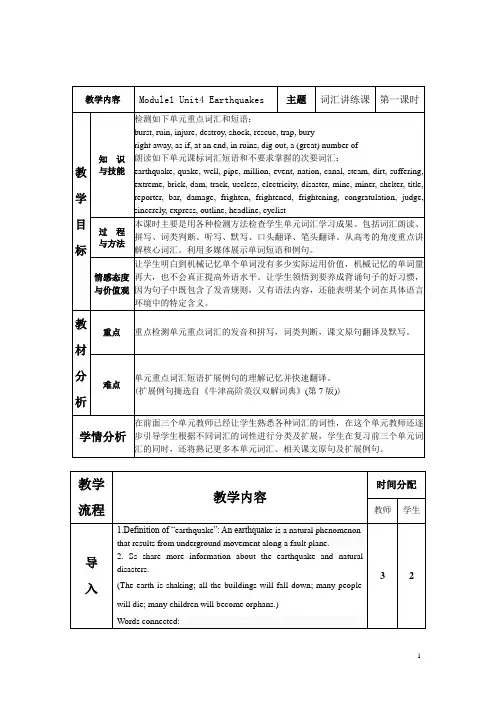
教学内容Module1 Unit4 Earthquakes 主题词汇讲练课第一课时教学目标知识与技能检测如下单元重点词汇和短语:burst, ruin, injure, destroy, shock, rescue, trap, buryright away, as if, at an end, in ruins, dig out, a (great) number of朗读如下单元课标词汇短语和不要求掌握的次要词汇:earthquake, quake, well, pipe, million, event, nation, canal, steam, dirt, suffering,extreme, brick, dam, track, useless, electricity, disaster, mine, miner, shelter, title,reporter, bar, damage, frighten, frightened, frightening, congratulation, judge,sincerely, express, outline, headline, cyclist过程与方法本课时主要是用各种检测方法检查学生单元词汇学习成果。
包括词汇朗读、拼写、词类判断、听写、默写、口头翻译、笔头翻译。
从高考的角度重点讲解核心词汇。
利用多媒体展示单词短语和例句。
情感态度与价值观让学生明白到机械记忆单个单词没有多少实际运用价值,机械记忆的单词量再大,也不会真正提高外语水平。
让学生领悟到要养成背诵句子的好习惯,因为句子中既包含了发音规则,又有语法内容,还能表明某个词在具体语言环境中的特定含义。
教材分析重点重点检测单元重点词汇的发音和拼写,词类判断,课文原句翻译及默写。
难点单元重点词汇短语扩展例句的理解记忆并快速翻译。
(扩展例句摘选自《牛津高阶英汉双解词典》(第7版))学情分析在前面三个单元教师已经让学生熟悉各种词汇的词性,在这个单元教师还逐步引导学生根据不同词汇的词性进行分类及扩展,学生在复习前三个单元词汇的同时,还将熟记更多本单元词汇、相关课文原句及扩展例句。
人教版高中英语必修一Unit4教学设计
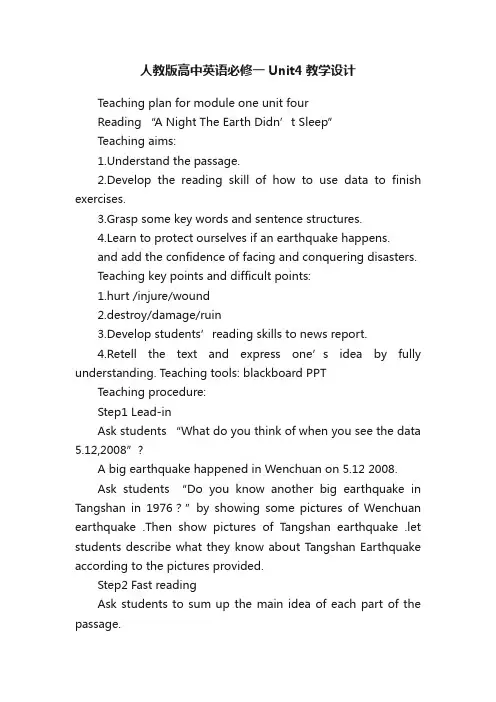
人教版高中英语必修一Unit4教学设计Teaching plan for module one unit fourReading “A Night The Earth Didn’t Sleep”Teaching aims:1.Understand the passage.2.Develop the reading skill of how to use data to finish exercises.3.Grasp some key words and sentence structures.4.Learn to protect ourselves if an earthquake happens.and add the confidence of facing and conquering disasters.Teaching key points and difficult points:1.hurt /injure/wound2.destroy/damage/ruin3.Develop students’reading skills to news report.4.Retell the text and express one’s idea by fully understanding. Teaching tools: blackboard PPTTeaching procedure:Step1 Lead-inAsk students “What do you think of when you see the data5.12,2008”?A big earthquake happened in Wenchuan on 5.12 2008.Ask students “Do you know another big earthquake in Tangshan in 1976?”by showing some pictures of Wenchuan earthquake .Then show pictures of Tangshan earthquake .let students describe what they know about Tangshan Earthquake according to the pictures provided.Step2 Fast readingAsk students to sum up the main idea of each part of the passage.Step3 Careful readingTask1. Read Part1 carefully and find out the proper information.Task2. Read Part2 to Part3 carefully first make a timeline and then fill in the blanks.Task3. Read Part3 carefully and answer questions.Step4 After-readingFill in blanks with proper words after reading the whole passage. Students work in groups and then give their answers. Then teacher explains key words and phrases.1.burst n/vi a burst of applause burst into+n=burst out+ving(突然……) burst into/out of 闯入/冲出2.think little/nothing of 轻视 think much of 重视think well/highly/poorly of对……评价好/高/低3.(be)at an end 结束;终结 come to an end 结束bring/put…to an end = bring/put an end to…使……终止4.be/lie in ruins 成为废墟 fall into ruin破败不堪bring sb. to ruin 毁灭某人 come/go to ruin 走向毁灭ruin one's health/fame/hope毁坏某人的健康/信誉/希望Step5 Language points1.Teacher brings up difficult points and ask students questions.2.Teacher sums up after students’answer.3.Do some exercises to reinforce knowledge.1.rise/raiserise(rose,risen) vi (日月星辰烟雾气,河水物价温度计,起义起床和起立) raise(raised, raised)vt raise one’s hand2..ruin/destroy/damageruin n/vt 指严重的以至于不能修复的“破坏”,但这种破坏不指毁灭而是长期损坏的结果,它也可用来表示抽象概念。
人教版英语必修一Unit 4教学教案
Wells:
Animals:
Lights and sound:
Water pipes:
People of the city thought______________ and______________
While the earthquake:
At 3:42 am
→Step 7 Homework
1. Learn the new words and expressions in this part by heart.
2. Read the text again and again and write a summary of the text.
Exercise1 Questions:
D、dams and wells were useless.
E、they didn’t know what the strange events meant.
Exercise2
Time
What happened
Result
Before the earthquake:
three days before the earthquake
一、Join the correct parts of the sentences.
1 The chickens didn’t eat because
2 The people didn’t worry because
3 Such a great number of people died because
4 Water was needed because
5 The people did not lose hope because
英语人教版高中必修一(新课标)教案Unit 4 Listening and Speaking 教案
Unit 4 Natural DisastersPeriod 1Listening and Speaking教材分析本单元以自然灾害为话题,探讨在“人与自然”的主题之下,当人类面临自然灾害的威胁时,应该树立防灾意识,提高在灾害中逃生和生存的能力。
主题图的内容是汶川地震时解放军战士在废墟中运送伤者的感人画面,体现了在发生重大自然灾害时军民同心,合力救助受灾人员的大无畏的人道主义精神。
而开篇页的引言“Live to Tell: Raising Awareness, Reducing Mortality.”中文可以译为:“用生命呼吁:增强减灾意识,减少人员伤亡。
”这句话是2016年联合国世界减灾日的活动主题,目的是呼吁全球各地的人们重视自然灾害,树立防灾意识。
听力板块的活动主题是“播报自然灾害”(Report natural disasters)。
学生通过观看视频并听新闻播报,最终完成模拟播报自然灾害新闻的活动。
教学目标1. 能正确理解使用下列词汇:disaster, drought, slide, flood, rescue, damage, destroy, death, affect, shelter。
2. 能根据听力问题,预判听力内容并能提炼出关键信息,例如:数字、时间、日期、事由等。
3. 了解新闻播报应包含的基本要素和语言特征。
4.能够简要模仿新闻播报,报道突发的自然灾害。
5. 复习清辅音和浊辅音p/b、t/d、k/g、f/v、th、s/z、sh/g、ch/dg、tr/dr、ts/ds的发音规律,并利用这些规律准确辨音,有效记忆单词。
教学重难点【教学重点】1. 引导学生运用听力策略,主动思考、预判听力要点;2. 引导学生运用新闻套语,模仿听力文本,完成自然灾害的新闻播报。
【教学难点】掌握听前预判听力要点的策略和技能。
教学过程Task 1Step 1 Warming-up1.Look at the opening page and discuss the following questions.(1) What problems/natural disasters do you see in the picture?(2) What do you think the soldiers are doing?(3) Can the person in the picture survive?(4) Can we stop natural disasters from happening?2. Read the quote and discuss the following questions.How do you understand the quote? Do you agree with it?设计意图:通过询问学生对引言的看法,启发学生思考,培养学生的思辨能力。
高一英语必修1 unit4教案(全单元)
一.教学内容分析本单元话题为“地震”,主要描写了1976年唐山大地震,各项语言活动也都是围绕地震展开。
本单元共分八个部分。
Warming-up 部分通过两张图片引出话题“一旦地震发生,将会造成怎样的危害”,为后面的主题作了一个热身运动。
Pre-reading 部分设置了两个开放性问题,目的是增加学生的生活常识,提高他们的应变能力。
这部分为接下来的阅读作了很好的铺垫,学生可通过套乱,参阅有关地震的书籍并运用一些生活常识来回答这两个问题。
Reading 部分具体描写了1976年唐山大地震的震前、震中和震后。
作者详细描述了地震来临前的一些不正常的自然现象及动物的反常表现;地震的来势汹汹并在顷刻间将整座城市夷为平地;震后人们勇敢面对现实并及时实施抢救和重建工作。
Comprehending 部分包括三组练习,主要目的是为了帮助学生更好地理解Reading 部分的文章。
Learning about Language 部分分为两个部分:Discovering useful words and expressions和Discovering useful structures.第一部分要求学生在把握文章的基础上,掌握重点词汇的词义及时用,这更注重培养学生运用上下文猜测词义的能力。
其次还对一些复杂的数字读法进行了检测。
第二部分则结合文章学习定语从句。
Using Language 部分分为Reading ,Writing and Speaking ;Listening 和Writing 。
Reading ,Writing and Speaking 包括读一篇邀请函,写一份演讲稿和关于一套新唐山邮票的Little talk 。
Listening 部分讲述了一位地震幸存者的故事,并根据听力材料进行正误判断和回答问题,旨在培养学生获取细节的能力,并通过听来模仿标准的语音和语调。
Writing 部分要求学生报纸写一篇新闻报道,学习如何按照规范的步骤进行写作,如选择适当地标题和组织语言等。
人教版英语必修一Unit 4(Reading)教案
Teaching DesignBook1 Unit4 Earthquakes ---ReadingTeaching Aims :(教学目标)1. Knowledge aim:Know the basic knowledge about earthquake.2. Ability aim:Learn to use different reading skills.3. Moral aim:Learn to face difficulties bravely.Teaching Important Points: (教学重点)1.Get the students to know basic knowledge about natural disasters.2. Get the students to learn about Tangshan Earthquake.3. Get the students to learn different reading skills.Teaching Difficult Points: (教学难点)Develop the students’ reading ability.Teaching Methods: (教学方法)1.Task-based teaching and learning2. Cooperative learning3.Discussion.Teaching Aids:(教学辅助)1. a multimedia classroom2. The blackboardTeaching Procedures: (教学过程)Step1: leading-in:Pictures Natural disasters earthquakeStep2: Read the text quickly and pay attention to the first sentence of each paragraph and answers the questions:1.In what order was the passage written?2.What is the general idea of the passage?Type of writing: ___________ This is a news report.____________________________Topic sentence of Paragraph 1:_______________________________________________ ________________________________________________________________________ Topic sentence of Paragraph 2:_______________________________________________ ________________________________________________________________________ Topic sentence of Paragraph 3:_______________________________________________ ________________________________________________________________________ Topic sentence of Paragraph 4:_______________________________________________ ________________________________________________________________________ General idea of the passage:_________________________________________________ Step3: Careful reading: (for example)Part1: Ask and Answer:1.When and where were the strange things happening? What are they?2.Why did the text say the world seemed to be at an end?3.How was the city destroyed after the earthquake?4.When did the second earthquake hit the city? What was the result of that?5.Who came to help Tangshan first ? And how?Part2: True or False:1.People in Tangshan were warned of the earthquake and didn’t go to bed as usual thatnight.2.People in Beijing also felt the earthquake.3.More than 400,000 people were killed in the earthquake.4.Many rescue workers and doctors were trapped under the ruins during the aftershock.5.People tried to get fresh water from under the ground in Tangshan.Part3: English and Chinese: (typical sentences)1. But the one million people of the city, who thought little of these events,were asleepas usual that night.2. it was felt in Beijing,which is one hundred kilometers away.3.In fifteen terrible seconds a large city lay in ruins.4.People began to wonder hoe long the disaster would last.5.All hope was not lost.6.Slowly the city began to breathe again.Step4: Deep reading:1.Which sentence in the text of reading can replace the following sentence?The city will not die,she has hope and she can recover from the pain._______________________________________________________________2.Why does the writer use A NIGHT THE EARTH DIDN’T SLEEP as the title?________________________________________________________________Step5: Rewriting________________ happened in Tangshan. For there days, water in the wells _________________. From the ________ of wells _____________ came out.Chicken , pigs and mice became ___________. Fish jumped ____________bowls and ponds. At 3:42 am, everything began to __________. It seemed that the world was __________________. ____________of the nation ________it. ________________ cut across the city. The city lay ______________. Two-thirds of the people died or _________________. People began _______________________________________. But all hope ___________________, soldiers came to help those ______________. Slowly, the city began to __________________.Step6: Summarizing and discussingStep7: Homework1.Write a short passage about the Tangshan earthquake.2.One acts as a reporter,and the other acts as a survivor to make a dialogue.3.。
- 1、下载文档前请自行甄别文档内容的完整性,平台不提供额外的编辑、内容补充、找答案等附加服务。
- 2、"仅部分预览"的文档,不可在线预览部分如存在完整性等问题,可反馈申请退款(可完整预览的文档不适用该条件!)。
- 3、如文档侵犯您的权益,请联系客服反馈,我们会尽快为您处理(人工客服工作时间:9:00-18:30)。
高中英语学习材料***鼎尚图文理制作***Teaching plan for unit 4Teaching aims and demands:1. Topic:Basic knowledge of earthquakes; how to protect oneself and help the others in disasters2. Useful words and expressions:earthquake, quake, right away, well (n.) , million , event , pipe, burst, as if, at an end , nation , canal, steam, dirt, ruin, in ruins , suffering, extreme, injure, destroy, brick, dam, track, useless, steel, shock, rescue, trap, electricity, disaster, dig out, bury, mine, miner, shelter, a (great ) number of , title, reporter, bar, damage, frighten, frightened, frightening, congratulation, judge, sincerely, express, outline, headline, cyclist3. Functions:Talking about past experiences:I will never forget the day when the earthquake took place. The time was 5:15 in the afternoon and I was driving along the road.Sequence4. Grammar:The attributive clause (I)由that, which, who, whose引导的定语从句The number of people who were killed or injured reached more than 400,000.It was heard in Beijing which is one hundred kilometers away.Workers built shelters for survivors whose homes had been destroyed.Teaching procedures:Period 1.Step 1. Warming upSs discuss and answer some questions:1. Which of the following may cause people the greatest damage?A. earthquakeB. typhoonC. floodD. drought2.Imagine your home begins to shake and you must leave it right away. You have time to take only one thing. What will you take? Why?Step 2. Pre-readingSs discuss and answer:1.Do you know what would happen before an earthquake?2.What can we do to keep ourselves safe from an earthquake?3. Do you know anything about Tangshan Earthquake in 1976?Step 3. Reading1.Skimming and find the answers to the following questions:a.What happened?b.When and where did it happen?3.Ss read the whole passage again and get the main ideas of each part:Part 1. The natural signs of a coming earthquakePart 2-3. The damage of the city after the earthquakePart 4. The help to the survivorsStep 4. ComprehendingSs finish Ex 1 and 2 on page 27.Step 5. Assignment1.Surf the internet and get more information about the earthquake.2.Retell the text.Period 2.Step 1. Warming up1.Ss share more information about the earthquake.2.Ask some Ss to retell the text by using their own words.Step 2. Language points1.lie –lay-lain (v.) : to be, remain or be kept in a certain state 处于某种状态The village lay in ruins after the war.These machines have lain idle since the factory closed.2.in ruins: severely damaged or destroyed 毁坏an earthquake left the whole town in ruins.His career is in ruins.3.number (n.): a quantity of people or things 数目;数量The number of people applying has increased this year.We were fifteen in number.a number of: a lot ofI have a number of letters to write.A large number of people have applied.4. injure (v.): to hurt oneself/sb./ sth. physically 受伤He fell off the bicycle and injured his arm.5. reach (v.): to achieve or obtain sth. 达成;达到;获得You’ll understand it when you reach my age.At last we reached a decision.6. rescue (n.): an act of rescuing or being rescued 搭救;解救A rescue team is trying to reach the trapped mines.Rescue (v.): to save or set free from harm, in danger, or loss 解救;救出The rescued the man from drowning.7. trap(v.): in a place from which one wants to escape but cannot 困住;陷于绝境They were trapped in the burning hotel.8. all …not… = not all…: some but not all 一些;但不是全部Not all the girls left.=Only some of them left early.Not all the children are noisy.=Some of the children are not noisy.全部否定应用: none of…None of us were allowed to go there.None of these reports is very helpful.Step 3. learning about language1. Ss finish Ex 1,2 and 3 on page 27 and 28.2. Teacher checks the answer and give the Ss some help if they have some difficulty. Step 4. assignment1.Finish Wb.Ex.1 on page 63.2.Ss try to remember the useful words and expressions by hearts.Period 3Step 1. Warming upSs read the passage again and try to find the sentences with attributive clauses.e.g. Workers built shelters for survivors whose homes had been destroyed.Step 2. Attributive clause1.Give Ss more sentences and let the Ss to find the structures of the attributiveclause.2.Ss do some exercises about how to use that, which, who or whose.3.Ss finish Ex 2 on page 28.Some materials about attributive clause:关系代词引导的定语从句关系代词所代替的先行词是人或物的名词或代词,并在句中充当主语、宾语、定语等成分。
关系代词在定语从句中作主语时,从句谓语动词的人称和数要和先行词保持一致。
1)who, whom, that这些词代替的先行词是人的名词或代词,在从句中作主语和宾语。
